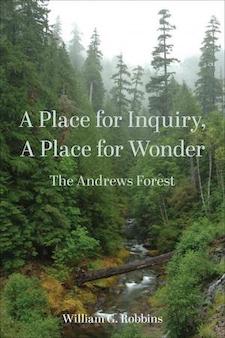A Place for Inquiry, A Place for Wonder: The Andrews Forest
Last Updated on November 21, 2022 by

by William G. Robbins
ISBN 9780870710193
Oregon State University Press, Corvallis, Oregon., 2020
William Robbins has produced the first comprehensive historical account of the origins, development, and importance of the H.J. Andrews Experimental Forest. This renowned research forest, commonly referred to as the Andrews, is located near Blue River and managed cooperatively by the Forest Service’s Pacific Northwest Research Station, Oregon State University, and the Willamette National Forest. The author is an Emeritus Distinguished Professor of History at Oregon State University who has previously written about the forest. He waded through countless historical documents to glean the turning points of a 70+ year chronology. In two hundred pages, he outlines the external forces that shaped the early direction of research, highlights the most pivotal personalities, programs, and events, and traces how research emanating from this Place for Inquiry has shaped national policy.
But the wonder is missing. I was fortunate enough to experience that wonder several times. I found it amid the peace and sanctity of the old-growth forest itself while undertaking an undergraduate research project in 1991. Later, as a graduate student, I experienced it while delving into the collective wisdom of the generations of researchers who came before me. I was awed by the continuity of time and the complexity of the products of natural selection and humbled by the scale of my own contributions and the insignificance of our species in an ecosystem that has vastly less need for us than we have for it.
In the introduction, Robbins provides a dispassionate, albeit concise, summary of the history and importance of the Andrews, and the subsequent seven chapters continue to trace that history in dry detail. In the first chapter, he describes the historical context of its 1948 establishment and initiation into the International Biological Program. The subsequent multi-disciplinary ecosystem research that led to its participation in the UNESCO Man and the Biosphere and the NSF-funded Long Term Ecological Research programs is the topic of the second chapter. The origins of old-growth research on the Andrews are recorded in the third chapter, including how this research led to the listing of the northern spotted owl as an endangered species and to the advent of a new, less commodity-oriented philosophy toward forest management known as “new forestry.” The fourth chapter highlights the political fallout of these developments, which culminated in a Northwest Forest Plan meant to balance needs for both wildlife habitat and economic stability. Robbins frankly reports on the success of the plan to conserve old-growth, as well as its failure to sustain timber-dependent communities.
In the fifth chapter, Robbins characterizes the adverse political climate in which research into ecosystem science took place at the end of the 20th century. He describes public and educational outreach (e.g., the NSF-funded Research Experiences for Undergraduates program in which I participated) as well as ongoing research into biodiversity. In the final chapter, Robbins documents the experiences, and quotes the resulting works, of various writers who found inspiration while in residence at the Andrews (and Mt. St. Helens) through programs promoting the intersection of the sciences and the humanities. In conclusion, Robbins notes that the decades-long research at the Andrews continues to shape forestry, scientific thought, and national and global environmental policy at a critical time for understanding the ecosystem-wide effects of climate change.
The consummate academic historian, Robbins has produced a mechanistic accounting of the times, places, events, and some of the people comprising the Andrews—which makes for a satisfactory documentary record, but a disappointing casual read. Although the elements of history have been strung together in a chronological sequence, in the absence of a narrative thread readers are left to piece together linkages on their own. The extensive but dusty documentation from which this history was extracted is presented with unnecessary repetition and factual quotations that provide little insight. Historical tidbits suddenly appear without preamble, context, or interpretation, choppily tied together. Periodic attempts to humanize the text by interspersing personal accounts seem to be detached digressions, only tangentially related to the Andrews. Even the quotations of artists who spent time at the Andrews fail to convey the sense of wonder their visits must surely have inspired.
Which is a little surprising, because wonder flows from at least two wellsprings on the Andrews. I can appreciate how a casual visitor might miss the academic wellspring—perhaps only a fellow researcher can feel humbled and awed by the accumulated wisdom and voluminous research spanning over seven decades. But the wonder and majesty of the old-growth forest underlying this research is easily accessible to the public through the Lookout Creek Old-Growth trail. The trail winds through the forest under towering 500-yr-old trees too large to hug and alongside massive logs rotting so slowly that they remain obstacles for centuries after toppling to the ground. To be fair, academicians must walk a tightrope between objectivity and passion, but the products of the former should not be mistaken for popular literature. Read A Place for Inquiry, A Place for Wonder to understand how it came to be a place for inquiry but visit the Andrews to discover it as a place for wonder.
—Jeri Peck, former Oregonian, now Research Associate at Pennsylvania State University
